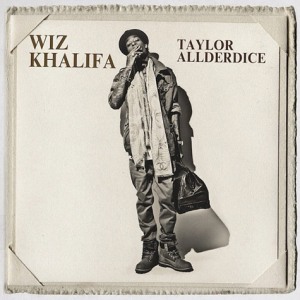“When you talk about longevity, you can’t base that on one year, or six months, or eight months, or anything like that… I was speaking to anybody who’s riding with me for the long run, and who’s looking for the next thing for me to do”.
–Wiz Khalifa on his comments in “Strictly For My Taylors”
A quick flashback to last year would be indicative of Wiz Khalifa’s meteoric rise to stardom. At this time in 2011, Wiz had just released his major label debut Rolling Papers to lackluster reviews after experiencing his first mainstream success behind the hit record “Black And Yellow”.
Fast forward and TGOD supporters around the world rejoice as the 24 year-old Pittsburgh native is back on the scene with his newest project Taylor Allderdice.  Named after Wiz’s high school alma mater, the project shows a return to the form he had prior to his Atlantic Records venture. During that span, Wiz enlisted a shortlist of producers and engineers (Sledgren, Cardo, Big Jerm, Johnny Juliano, I.D. Labs) to create synth-heavy, bass-blaring, listener-engaging instrumentals which were crafted specifically to fit his signature deliveries and lyrical content, the latter of which is centered on his heavy usage of marijuana and his party lifestyle. Taylor Allderdice sees Wiz bringing back a sound which fans have come to expect from him, and that’s definitely not a bad thing.
Named after Wiz’s high school alma mater, the project shows a return to the form he had prior to his Atlantic Records venture. During that span, Wiz enlisted a shortlist of producers and engineers (Sledgren, Cardo, Big Jerm, Johnny Juliano, I.D. Labs) to create synth-heavy, bass-blaring, listener-engaging instrumentals which were crafted specifically to fit his signature deliveries and lyrical content, the latter of which is centered on his heavy usage of marijuana and his party lifestyle. Taylor Allderdice sees Wiz bringing back a sound which fans have come to expect from him, and that’s definitely not a bad thing.
The qualities and characteristics of Taylor Allderdice are largely comparable to some of Wiz’s more recent works. For instance, the more aggressive atmosphere which Wiz attempted to achieve with Cabin Fever has a presence on Taylor Allderdice. With songs like “Taylor Gang” and “Homicide” being huge fan favorites last year, it’s good to see Wiz incorporating this sound into this new project with records like “Guilty Conscience”, “T.A.P.”, and “The Code”. Simultaneously, fans of Kush & Orange Juice will appreciate the cohesive sound of Taylor Allderdice. Whether it’s the flow-heavy rapping and melodic choruses which spawn memorable records, or if it’s the familiar production styles and thematic interludes which provide a packaging for those records, Taylor Allderdice sees Wiz and the gang perfectly meshing these essential song qualities in order to craft a project which is wholly enjoyable and plays like a soundtrack fitting of a stoner lifestyle (no Mac and Devin…).
Taylor Allderdice has several standout tracks for the listeners to enjoy. The inaugural record “Amber Ice” is likely to be the smoothest opening to any of Wiz’s projects to date, while “Mary 3x” is more than serviceable as the “weed song” this time around. The beauty of Taylor Allderdice is that the project gets better after it reaches its midpoint. “Rowland” (track 10) features fellow emcee Smoke DZA and captures a vibe which is faintly reminiscent of Wiz’s How Fly days with Curren$y. “My Favorite Song” sees the Academy Award-winning Taylor Gang member Juicy J make his first of three straight appearances on the project. The song is produced by Rob Halladay (of Yung Berg “Sexy Lady” fame) and is slightly infectious to say the least. Next up, the SpaceGhostPurrp-produced “T.A.P.” slows the pace and brings a more bass-heavy production for Wiz and Juicy J to takeoff to. Finally, a Lex Luger production finds its home on the project as “The Code” lets the Taylor Gang (Wiz, Chevy Woods, Juicy J, & Lola Monroe) engage in a new-school posse cut. While the momentum gained by these four records is somewhat lost after the project fails to go out with a bang, Wiz’s effort is still commendable.
In summary, Wiz Khalifa fans will appreciate and enjoy Taylor Allderdice for the foreseeable future and add it to their collection of Pittsburgh-penned marijuana music. Hopefully, this project is foreshadowing of good things to come for Wiz and the Gang.
Pros:
+Serves as a nice rebound from Rolling Papers
+Returns to the use of in-house producers/engineers, with efficient use of outside production
+Further demonstrates Wiz’s ability to craft cohesive projects
+ “Mary 3x”, “Rowland”, “T.A.P.”, “The Code”
Lows:
–Closes out with lackluster, filler-quality songs
–Shows a lack of growth in terms of subject matter; no expansion or evolution
–“Brainstorm”, “Number 16”, “Blindfolds”
Listening Rating:
3.9/5, BA[S]ICs
STRONG

 The newest of these albums, titled Echoes Of Silence, is the final installment of the Canadian artist’s “Balloon Trilogy” (Echoes Of Silence was preceded by the projects House Of Balloons and Thursday). The series has made Tesfaye one of the year’s most acclaimed newcomers, and Echoes will only serve to add to his massive buzz.
The newest of these albums, titled Echoes Of Silence, is the final installment of the Canadian artist’s “Balloon Trilogy” (Echoes Of Silence was preceded by the projects House Of Balloons and Thursday). The series has made Tesfaye one of the year’s most acclaimed newcomers, and Echoes will only serve to add to his massive buzz. These topics are touched on from the outset of the album and remain present until the end of it. For instance, Camp begins with “Outside”, a track which sees Gambino revisiting his past in order to provide a back story of sorts for the listener. The song details stories of Gambino’s upbringing, touching on several of the aforementioned themes of the album in the process. With lines like “I just want[ed] to fit in, but nobody was helping me out/they’re talking ‘hood s–t and I ain’t know what that was about”, Gambino is able to express how he was a social pariah growing up. Similarly on “Hold You Down”, Gambino speaks on the exclusionary tactics of racism, as well as ostracism within his own race. Stating that “N—-s got me feeling I ain’t black enough to go to church/culture shock in barber shops because I ain’t ‘hood enough”, he shows that his outcast identity has followed him from childhood into his adult life and spreads further than he previously thought. Tracks like “All the Shine” see Gambino turning the lens on himself, offering pieces of self-criticism concerning his identity and authenticity in life and in music. These various storylines are woven together throughout the album and create content that listeners can identify with. The ability to craft relatable material for listeners is one of the strengths showcased on Camp, and will ultimately play a huge part in Gambino’s success as an artist.
These topics are touched on from the outset of the album and remain present until the end of it. For instance, Camp begins with “Outside”, a track which sees Gambino revisiting his past in order to provide a back story of sorts for the listener. The song details stories of Gambino’s upbringing, touching on several of the aforementioned themes of the album in the process. With lines like “I just want[ed] to fit in, but nobody was helping me out/they’re talking ‘hood s–t and I ain’t know what that was about”, Gambino is able to express how he was a social pariah growing up. Similarly on “Hold You Down”, Gambino speaks on the exclusionary tactics of racism, as well as ostracism within his own race. Stating that “N—-s got me feeling I ain’t black enough to go to church/culture shock in barber shops because I ain’t ‘hood enough”, he shows that his outcast identity has followed him from childhood into his adult life and spreads further than he previously thought. Tracks like “All the Shine” see Gambino turning the lens on himself, offering pieces of self-criticism concerning his identity and authenticity in life and in music. These various storylines are woven together throughout the album and create content that listeners can identify with. The ability to craft relatable material for listeners is one of the strengths showcased on Camp, and will ultimately play a huge part in Gambino’s success as an artist.